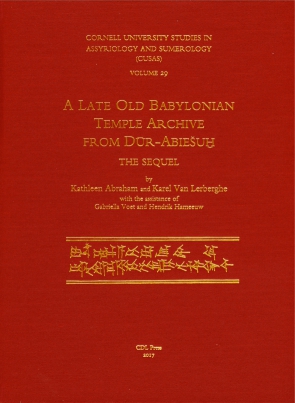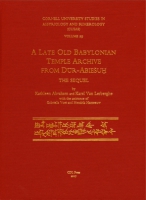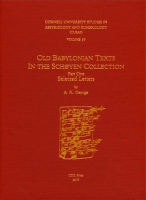
CUSAS 29
A Late Old Babylonian Temple Archive from Dur-Abiesuh: The Sequel
Kathleen Abraham and Karel Van Lerberghe
CUSAS 29
A Late Old Babylonian Temple Archive from Dur-Abiesuh: The Sequel
Kathleen Abraham and Karel Van Lerberghe
CUSAS 29 (2017) contains a critical edition of 206 tablets from the Rosen Collection at Cornell University and come from the archive at Dur-Abieshuh on the Hammurabi-nuhush-nishi canal. The volume constitutes a continuation of the 89 texts published previously in CUSAS 8 (2009). The archive can now be dated to between the first years of the reign of Abieshuh and the final years of Samsuditana. While the material presented in CUSAS 8 revealed that Nippur, the sacred city of Enlil and the center of learning, was at least still partially inhabited in the late Old Babylonian period, this volume provides deeper insights into the social, economic, and military structures of the South at the end of this period and adds substantially to our knowledge of the history, geography, social and military institutions during the late Old Babylonian period, particularly in the region of middle and southern Babylonia.
- Description
- Table of Contents
CUSAS 29 (2017) contains a critical edition of 206 tablets from the Rosen Collection at Cornell University and come from the archive at Dur-Abieshuh on the Hammurabi-nuhush-nishi canal. The volume constitutes a continuation of the 89 texts published previously in CUSAS 8 (2009). The archive can now be dated to between the first years of the reign of Abieshuh and the final years of Samsuditana. While the material presented in CUSAS 8 revealed that Nippur, the sacred city of Enlil and the center of learning, was at least still partially inhabited in the late Old Babylonian period, this volume provides deeper insights into the social, economic, and military structures of the South at the end of this period and adds substantially to our knowledge of the history, geography, social and military institutions during the late Old Babylonian period, particularly in the region of middle and southern Babylonia.
Table of Contents:
Series Editor’s Preface
Acknowledgments
Bibliography
Concordance
Dimensions
Introduction
The Texts
Indexes
Personal Names
Professional Names
Places and People
Divine Names
Distinctive Buildings
Tablet Copies, Plates I–CCXXVIII
Photographs and Illustrations of Seal Impressions, Plates CCXXIX–CCLVI
Also of Interest
Mailing List
Subscribe to our mailing list and be notified about new titles, journals and catalogs.




